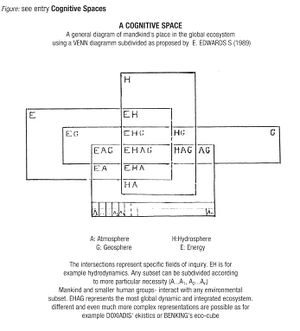COGNITIVE SPACES
| Collection | International Encyclopedia of Systems and Cybernetics |
|---|---|
| Year | 2004 |
| Vol. (num.) | 2(1) |
| ID | ◀ 484 ▶ |
| Object type | General information |

Each individual has his/her proper cognitive space, i.e. a perceptive capacity.
The dimensions of this cognitive space depend on information , training and finally on a person's awareness . All this depends globally from the cultural setting.
While in general terms this is clearly described by D. MEADOWS et al. graph of human perspectives (1972, p. 19), the two-dimensional graph can be expanded in the third dimension, as showed by H. BENKING, in order to take many different aspects of the general environment . While one can be specially interested in some economic (or ecological, or cultural, or…) issue , a more general and global, but at the same time more complex view can only be acquired by collaborating and conversational groups.
In this sense Benking distinguishes subjective views and objective ones. The subjective views, are related to the different aspects of perceived environment that can be considered at the same moment by different observers or at different moments by the same observer. The objective view tries to describe the environment at micro -, meso - and macroscale , in the short , medium or long-term time scale (see www.benking.de/cube/)
See also
'Cognitive panorama, Eco-cube, Metaphors (classes of), Venn diagram'figure below